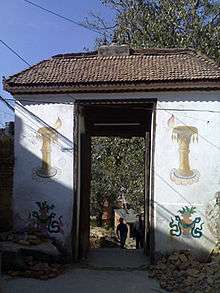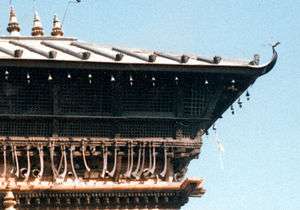Kalu Pande
Vamshidhar Pande (Nepali: वंशीधर पाँडे) known by sobriquet Kalu Pande (Nepali: कालु पाँडे) was a Nepalese politician and military general who was appointed as Kaji of The Gorkha Kingdom. He was born in 1713 A.D in Gorkha. . He was the commander of the Gorkhali forces during the Expansion Campaign of Nepal. He died in the first Battle of Kirtipur in 1757 A.D. His real name was Banshidhar Pande. He was a son of Kaji Bhimraj Pande who was minister during reign of King Prithivipati Shah of Gorkha. He was descendant of Minister of Gorkha and Dravya Shah's accomplice Ganesh Pande. He had three sons: Dewan Kajisaheb Vamsharaj Pande, Sardar Ranasur Pande and Mulkaji Sahib Damodar Pande (1st PM of Nepal).[1]
Vamshidhar "Kalu" Pande | |
|---|---|
श्री काजी वंशीधर "कालु" पाँडे | |
 Kaji Kalu Pandey of Gorkha Kingdom | |
| Chief of the Nepalese Army | |
| In office ca. 1746 - 1757 | |
| Preceded by | Prithvi Narayan Shah |
| Succeeded by | Vamsharaj Pande, Abhiman Singh Basnet |
| Personal details | |
| Born | Vamshidhar Pande 1713 A.D. Gorkha Kingdom (present day Gorkha District, Nepal) |
| Died | 1757 A.D. (aged 43-44) Tyanglaphant Kirtipur, Kirtipur Kingdom (present day Kathmandu District, Nepal) |
| Nationality | Nepali |
| Children | Vamsharaj Pande, Ranashur Pande, Damodar Pande |
| Father | Kaji Bhimraj Pande |
| Relatives | Pande dynasty Basnyat family |
| Military service | |
| Battles/wars | Battle of Kirtipur, Unification of Nepal |
Family
He was born in 1713 A.D to Kaji Bhimraj Pande. He was a descendant of Ganesh Pande, who was the first Kaji (Prime Minister) of King Dravya Shah of Gorkha Kingdom established in 1559 A.D.[2][3] The Pandes were considered as Thar Ghar or aristrocratic family who assisted in the administration of Gorkha Kingdom.[4] Kaji Kalu Pande (1714-1757) belonged to this family[5] and became a war hero after he died at Battle of Kirtipur.[6] These Pandes were categorized with fellow Chhetri Bharadars such as Thapas, Basnyats and Kunwar family.[7]
Relation with Kaji Tularam Pande
Generally, historians conclude his relation to Kaji Tularam Pande of Gorkha. As per Historian Baburam Acharya, Tularam was a brother (first cousin) of Kaji Bhimraj Pande, the father of Kalu Pande.[8] However, Historian Rishikesh Shah contends that Tularam was a brother of Kalu Pande.[9]
Career
Kalu Pande was made the Commander-in-Chief of the Gorkhali Army after Biraj Thapa Magar and his first major Battle was the Battle of Kirtipur. Despite his initial resentment to the fact that the valley kings were well prepared and the Gorkhalis were not, Pande gave a 'Yes' to the operation, due to being insisted by Prithvi Narayan Shah. The Gorkhalis had set up a base on Naikap, a hill on the valley's western rim, from where they were to mount their assaults on Kirtipur. They were armed with swords, bows and arrows and muskets.[10]
Battle of Kirtipur

The Battle of Kirtipur occurred in 1767 during the Gorkha conquest of Nepal, and was fought at Kirtipur, one of the principal towns in the Kathmandu Valley.[11][12] Kirtipur was then a walled town of 800 houses and part of the kingdom of Lalitpur. It is spread along the top of a ridge.[13]
The battle between the Newars of the valley and the invading Gorkhalis marked a turning point in the war of expansion launched by Gorkhali king Prithvi Narayan Shah. It led to his subjugation of the rest of the coveted valley[14][15] and the end of Newar rule.[16] The Gorkhalis had set up a base on Dahachok, a hill on the valley's western rim, from where they mounted their assaults on Kirtipur. They were armed with swords, bows and arrows and muskets.[17]
During the first assault in 1757, the Gorkhali army was badly beaten. As they advanced towards Kirtipur, the Newars went to meet them under the command of Kaji Danuvanta. The two forces fought on the plain of Tyangla Phant in the north-west of Kirtipur. The Newars defended their town ferociously. The Gorkhali commander Kalu Pande was killed, and the Gorkhali king himself barely escaped with his life into the surrounding hills disguised as a saint.[18][19]
The Valley Kings brought a large number of Doyas from Indian Plains under Shaktiballabh sardar. During the first assault in 1757, the Gorkhali army killed 1200 enemies, mostly Doyas, but were badly beaten themselves. Both sides suffered heavy losses. As they advanced towards Kirtipur, the combined force of Valley Kings under Kaji Gangadhar Jha, Kaji Gangaram Thapa and Sardar Shaktiballabh brought Havoc to the outnumbered Gorkhalis. The two forces fought on the plain of Tyangla Phant in the northwest of Kirtipur. Surapratap Shah, the King's brother lost his right eye to an arrow while scaling the city wall. The Gorkhali commander Kaji Kalu Pande was beheaded by kantipur's king jay prakash malla himself, and the Gorkhali king himself narrowly escaped with his life into the surrounding hills disguised as a saint.[20][21]
King's disheartenment
King Prithvi Narayan Shah's letter to Sardar Ramakrishna Kunwar mentioned by historian Baburam Acharya quotes disheartenment of King Prithvi over death of Kalu Pande: "When Kalu Pande was killed in Kirtipur, I had felt disheartened, thinking that I had not been able to conquer the three towns of Nepal..."[22]
Marital Relationship with Basnyats
King Prithvi Narayan Shah formed an alliance with Basnyat and Pande families of Gorkha in his quest for the unification of Nepal.[23] As per his Divya Upadesh, King Prithvi Narayan is known to have arranged the marriage between Kaji Kehar Singh Basnyat, the second son of Senapati Badabir Shivaram Singh Basnyat, and Mukhiyani Chitra Devi, the daughter of Kaji Kalu Pande.[23][24] Shivaram Singh Basnyat was addressed as Senapati Badabir (Brave Chief of the Army) in all the documents of that era. He died in the defensive battle of Sanga Chowk during Unification of Nepal on 1803 B.S.[25][26]
Kalu Pande memorial

The burial ground of Kaji Kalu Pande on a hill top is a popular hiking spot. It lies in Chandragiri, western outskirts of Kathmandu from where Gorkha can be seen.[27]
Gallery
 Bamshidhar Kalu Pande
Bamshidhar Kalu Pande Kalu Pande
Kalu Pande unification during battle field
unification during battle field Memorial where Kalu Pande was assassinated in 1814 B.S.
Memorial where Kalu Pande was assassinated in 1814 B.S. Swords of Kaji Kalu Pande and his soldiers at Bagh Bhairab temple, Kirtipur
Swords of Kaji Kalu Pande and his soldiers at Bagh Bhairab temple, Kirtipur Kaji Kalu Pande statue at Dahachowk
Kaji Kalu Pande statue at Dahachowk
References
- http://knownepalshistory.blogspot.com/2015/10/kaji-kalu-pandey-great-warrior.html?m=1
- Regmi 1975, p. 30.
- Wright 1877, p. 278.
- Pradhan 2012, p. 8.
- Singh 1997, p. 126.
- Wright, Daniel (1990). History of Nepal. New Delhi: Asian Educational Services. Retrieved 7 November 2012. Page 227
- http://himalaya.socanth.cam.ac.uk/collections/journals/contributions/pdf/CNAS_02_01_09.pdf
- Acharya 1979, p. 43.
- Shaha 1990, p. 160.
- Vansittart, Eden (1896). Notes on Nepal. Asian Educational Services. ISBN 978-81-206-0774-3. Page 34.
- http://nepalarmy.mil.np/history.php?page=one
- "Archived copy". Archived from the original on 1 December 2017. Retrieved 29 March 2017.CS1 maint: archived copy as title (link)
- Giuseppe, Father (1799). "Account of the Kingdom of Nepal". Asiatick Researches. London: Vernor and Hood. Retrieved 18 October 2012. Page 308.
- Kirkpatrick, Colonel (1811). An Account of the Kingdom of Nepaul. London: William Miller. Retrieved 16 October 2012. Pages 381-385.
- Giuseppe, Father (1799). "Account of the Kingdom of Nepal". Asiatick Researches. London: Vernor and Hood. Retrieved 16 October 2012. Pages 316-319.
- Waller, Derek J. (2004). The Pundits: British Exploration Of Tibet And Central Asia. University Press of Kentucky. p. 171. ISBN 978-0-8131-9100-3.
- Vansittart, Eden (1896). Notes on Nepal. Asian Educational Services. ISBN 978-81-206-0774-3. Page 34.
- Majupuria, Trilok Chandra (March 2011). "Kirtipur: The Ancient Town on the Hill". Nepal Traveller. Archived from the original on 17 November 2015. Retrieved 18 October 2012.
- Wright, Daniel (1990). History of Nepal. New Delhi: Asian Educational Services. Retrieved 7 November 2012. Page 227.
- Majupuria, Trilok Chandra (March 2011). "Kirtipur: The Ancient Town on the Hill". Nepal Traveller. Archived from the original on 17 November 2015. Retrieved 18 October 2012.
- Wright, Daniel (1990). History of Nepal. New Delhi: Asian Educational Services. Retrieved 7 November 2012. Page 227.
- Acharya 1950, p. 95.
- Acharya & Narharinath 2014.
- Regmi 1995, p. 44.
- Shaha 1990, p. 27.
- Hamal 1995, p. 104.
- "Kalu Pandey Burial Ground being popular among Kathmandu hikers". thehimalayantimes.com. 26 March 2017. Retrieved 7 March 2018.